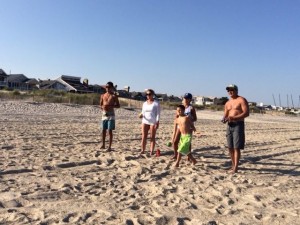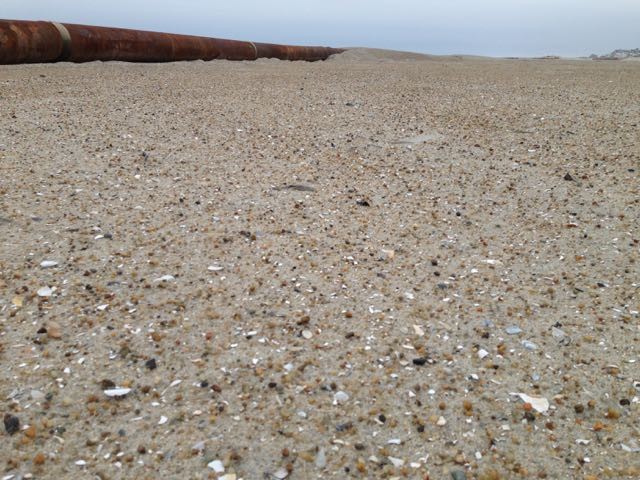To most beachgoers, the height and width of the rebuilt beaches on the south end of Ocean City are mighty fine. The sand is not.
Much of the replenished sand is grainy and riddled with small pebbles and broken seashells —not as fine as the native sand at the top of the beach or at the water’s edge.

“I’ve noticed,” said Jonathan Gricco, 37, of Bellmawr, Camden County, who was vacationing last week in Ocean City. “I cut my foot at least once. There’s just shells everywhere.”
Gricco was on the beach near 39th Street, flying a colorful kite with his nephew, 8-year-old Derek Wilson.
“We’re used to fine sand with a shell here or there, but this is, every step you take you’re stepping on broken shells,” Gricco said, looking down at his bare feet.
Wilson said he wasn’t bothered by the rough quality of the sand.
“I’m used to it,” he said with a smile.
The rebuilt beaches are part of a $57 million effort by the federal Army Corps of Engineers to reconstruct eroded beaches at the southern end of Ocean City (between 37th and 59th streets) and in Strathmere and Sea Isle City.
The Ocean City portion of the project is a few weeks away from completion. The new sand is a welcome addition to a portion of the island that saw the ocean meet the bay during Superstorm Sandy in October 2012. But much of the new beach has the sandpapery feel of something a Jersey Shore lover might find on the inferior shores of Cape Hatteras or Cape Cod.
So how did some parts of the beach end up with subpar sand? It has to do with the process that delivered the sand to the beach.
A hopper dredge — essentially a ship equipped with trailing suction — vacuums sand from the ocean floor in a collection area about two miles off Corson’s Inlet into the ship’s hold. The ship then carries the sand to another pipe that leads to the area where sand is discharged on the beach. There, the mixture of sand and water, called a slurry, travels through a basket designed to screen out unwanted objects such as seashells.
“We attempt to match the sand on the beach with the sand we pump ashore as closely as possible,” said Richard Pearsall, spokesman for the Army Corps.
“Once we begin pumping, we, the state, and the contractor all monitor the project, including the quality of the sand,” Pearsall said in an email, adding that small pebbles and shells can slip through the screening process. “The contractor (Great Lakes Dredge and Dock Company of Illinois) is required to sample and analyze the sand periodically ensure that it’s suitable. It takes a while for those results to get to us, but if the problem is gross in nature we will pick it up with inspection.
“We had a problem when the project first began, and that may be what’s showing up now,” Pearsall said. “The contractor addressed the problem then by moving to a different borrow area. The borrow area is big — 1,800 acres. Everyone involved in the project, including the contractor, is looking for the best sand possible. It’s easier to pump fine sand and easier on the equipment than coarser material. We will continue to monitor the situation.”
Mike Dattilo, assistant to Mayor Jay Gillian, said previously that the city has had some success in filtering stone from the sand on the already replenished beaches with its own beach-raking equipment. He said the city would continue the same process on all beaches as the project moves forward.
Work on the project began at 42nd Street in April, and the first phase of work (to 37th Street) included some of the roughest sand. Since then, the contractor has had mixed success in finding better quality for the beaches between 42nd Street and 54th Street. The final phase between 55th Street and 59th Street is underway.
The replenished beaches in Strathmere are received the same quality sand from a different dredge.

Caroline Brauckman, 12, a summer resident of Ocean City, played a game of bocce last week in the middle of the beach near 40th Street with the Martinez family from Lemont, Ill.
To avoid seashell shrapnel, “You have to go down really far or up close, and nobody’s really using this part of the beach” because of all the debris, she said.
Sergio Martinez, 51, said the difference in sand quality from his previous visits is apparent, especially to his feet.
“The sand was really fine before, almost Caribbean-like, and now it’s very choppy,” he said. “It’s good to have more beach, but it would be nice if it were more fine.”






